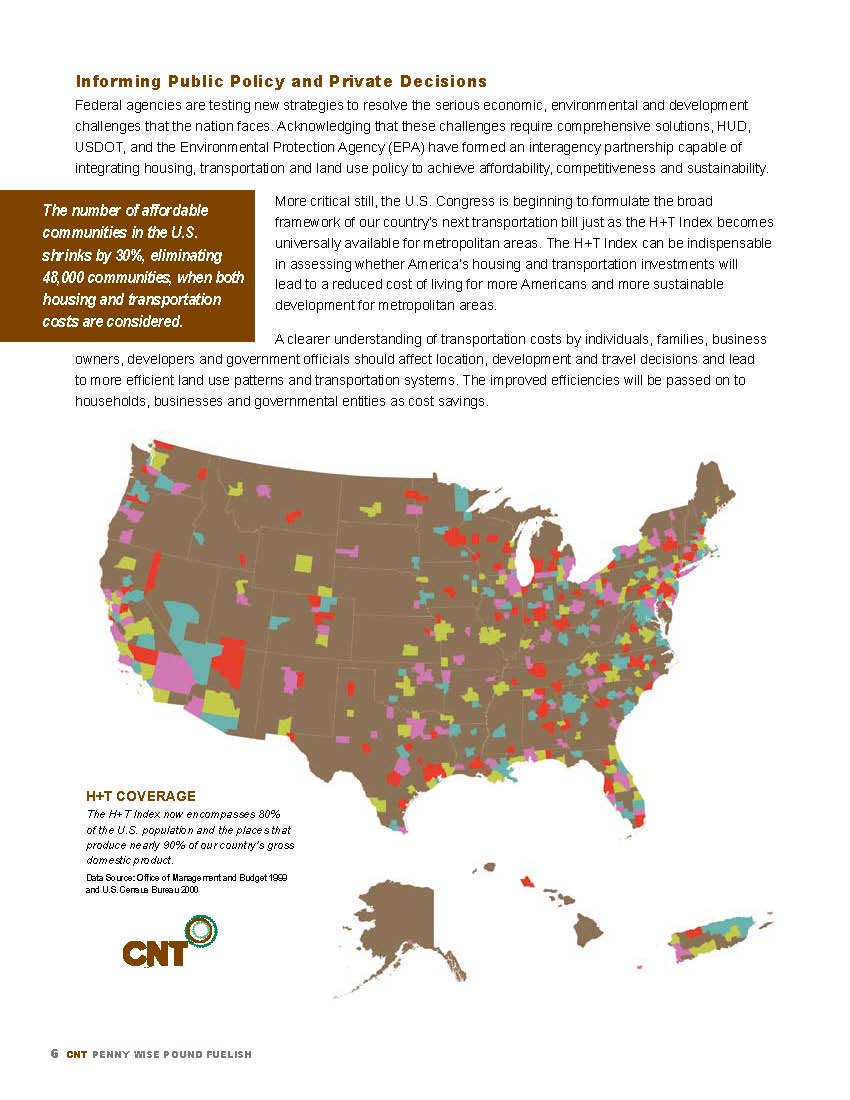CENTER FOR NEIGHBORHOOD TECHNOLOGY
EXECUTIVE SUMMARY
Penny Wise, Pound Fuelish serves as a guide to CNT’s H+T Index (www.htaindex.org), which includes 337 U.S. metropolitan regions. The Index demonstrates that the way in which urban regions have grown in the last half century has had negative consequences for many Americans:
- The number of communities considered affordable drops dramatically in most regions when the definition of affordability shifts from a focus on housing costs alone to one that includes housing and transportation costs;
- Families who pursue a “drive ‘til you qualify” approach to home ownership in an effort to reduce expenses often pay more in higher transportation costs than they save on housing thereby placing more, not less, stress on their budgets;
- Residents of “drive ‘til you qualify” zones are most sensitive to jumps in gas prices because of the distances they must drive; and
- The longer distances associated with sprawl also translate into more congestion on our highways, less leisure time with families as workers spend more time in their cars getting to and from jobs, and higher greenhouse gas emissions.
The Index reveals that communities with lower housing and transportation costs hark back to development patterns of the 19th and early 20th centuries with more compact construction and a blend of housing, jobs, stores and transit all within walking distance.
The report highlights the financial consequences to households and regions of the two approaches to development. Household savings from residing in a representative compact neighborhood rather than a dispersed community can range from $1,580 per year in Little Rock and $1,830 in Minneapolis to $3,110 in Chicago, $3,610 in Phoenix and as high as $3,850 in Boston—numbers that resonate with families seeking to tighten their belts during difficult economic times.
Regional savings have also been calculated for 12 metro areas using the same representative communities to highlight the aggregate impact if 50% of projected population growth through 2030 could live in more location efficient places. Such cost savings can total $239.8 million in a small region like Charlotte which is expected to almost double its population while San Francisco could register savings of $1.1 billion and Phoenix, $2.1 billion, by changing the way they grow.
The Index demonstrates the need for performance measures rooted in the realities that confront households trying to make ends meet and that regions confront when wanting to balance growth with the cost and quality of life, the amount of Greenfields lost to development, traffic congestion, infrastructure costs, improved economic competitiveness, and reduced carbon emissions. Penny Wise, Pound Fuelish concludes with federal policy recommendations to ensure that we build more livable and sustainable communities in the future.
Download full report (PDF): Pennywise, Pound Fuelish
About Center for Neighborhood Technology
www.cnt.org
“Founded in 1978, the Center for Neighborhood Technology has been a leader in promoting more livable and sustainable urban communities. In fact, our work focused on sustainable development before the term became as popular as it is today. As a creative think-and-do-tank, we research, invent, and test urban strategies that use resources more efficiently and more equitably.”
Tags: Center for Neighborhood Technology, CNT, H+T Index, Housing







 RSS Feed
RSS Feed